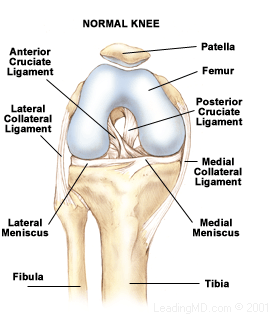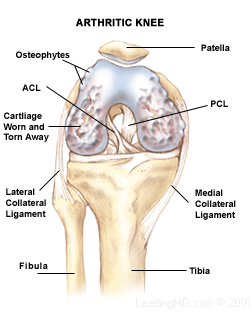
 Knee
arthritis affects millions of people each year. It is usually a progressive disease
leading to joint pain, stiffness, limitation of activity, and a decrease
in the quality of life. Knee arthritis can result from injury, from surgery
to remove part or all the meniscus cartilage, and can also be a part of
the normal aging process. There are two basic forms of arthritis: degenerative
osteoarthritis and systemic arthritis. Both
forms develop differently and attack the joint in different ways.
Knee
arthritis affects millions of people each year. It is usually a progressive disease
leading to joint pain, stiffness, limitation of activity, and a decrease
in the quality of life. Knee arthritis can result from injury, from surgery
to remove part or all the meniscus cartilage, and can also be a part of
the normal aging process. There are two basic forms of arthritis: degenerative
osteoarthritis and systemic arthritis. Both
forms develop differently and attack the joint in different ways. - Osteoarthritis is a degenerative condition that may affect many joints throughout the body. It causes changes in the cartilage structure that lead to its breakdown. Over time, complete loss of articular cartilage (on the ends of the bones) can occur. Changes in the underlying bone and cartilage loss can result in joint space narrowing, peripheral osteophytes (bone spurs), loss of motion, pain, and disability.
- Rheumatoid Arthritis is a systemic disease that affects the lining of all joints in the body. It causes an inflammatory response in the joint lining which destroys the articular cartilage and surrounding tissues.
What
is the knee joint and what does it do?
Anatomy
The knee is composed of the medial compartment including the medial meniscus,
and the lateral compartment including the lateral meniscus. It acts as
the hinge point during knee rotation and flexion / extension
(bending/straightening). There is also the patellofemoral compartment,
which is located under the patella (kneecap).
Function
The function of the knee is to provide stability and flexibility to the
lower leg while walking, running, stair climbing, and rising from a seated
position. It moves in bending, straightening, and rotation. These movements
describe the normal kinematics (function) of the knee. Ligament
disruption (such as anterior cruciate ligament injury) can compromise
the stability of the knee in the anterior (front) and posterior
(rear) direction as well as in rotation. If the meniscal cartilage
is removed, early arthritis may occur.
 What is knee arthritis and what does it do?
What is knee arthritis and what does it do?
Knee arthritis affects all cartilage in the knee. It leads to both biomechanical
and biochemical change that impairs the function of the cartilage. The
cartilage surfaces on the end of the femur, on top of the tibia, and under
the patella are responsible for distributing the weight of the body, shock
absorption, and knee joint lubrication. They are all impaired by the degenerative
changes of arthritis. If there is a loss of cartilage surface, the function
of the joint will degenerate over time.
Grades of severity of knee arthritis
Knee arthritis can lead to stiffness, poor function, physical deformity,
and increasing pain. The ability to exercise or even walk for any length
of time may also be affected. The grade of severity of arthritis is best
determined in an arthroscopic procedure (A tiny instrument
is used to look inside the knee joint).
-
Grade 1: Early changes show fissuring
(breaks) in the cartilage
Grade 2: More extensive full thickness breaks in the cartilage
Grade 3: Intermittent loss of cartilage with breaks
Grade 4: Exposed subchondral (below the cartilage) bone
Related conditions: Related conditions include poor alignment of the lower extremities, injury to knee cartilage and long term ligament instability. Other medical conditions that affect all joints of the body such as ankylosing spondylitis, rheumatoid arthritis or other systemic conditions can also cause degenerative changes in the knee.





